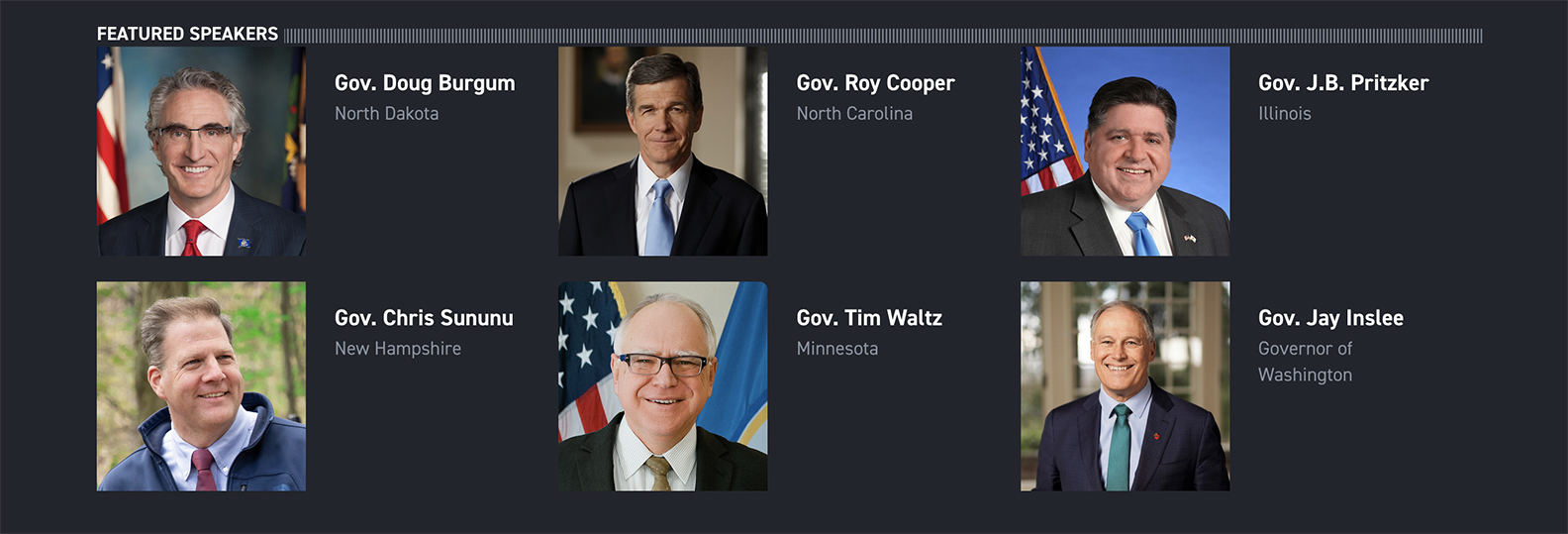Recently, I attended POLITICO’s “The Fifty: America’s Governors,” presented by Cisco, held during the National Governors Association (NGA) 2023 Winter Meeting in Washington, D.C. This event brought together six sitting governors and leaders from both the public and private sector to discuss workforce development, cybersecurity, digital equity, reimagining government services, and supporting critical infrastructure. The convening provided a unique forum to better understand the current political and technology environments state leaders are grappling with, and in our conversations with state government leaders throughout the weekend, three key priorities for state governments in 2023 became clear.
3 key priorities
My colleague, Rachel Barger, SVP of Americas Sales at Cisco, kicked off the program which included interviews between POLITICO reporters and six sitting governors (below) from across the country. Fran Katsoudas, Cisco’s EVP and Chief People, Policy, and Purpose Officer, joined to discuss how the tech industry is working with states to help them overcome obstacles.
During the event, three key priorities state governments will be dealing with throughout 2023 emerged:
- Digging in on workforce development.
- Investing in cyber resilience.
- Extending connectivity and addressing digital inequity.
Priority 1: Digging in on workforce development
Workforce shortages have reached a crisis point for the U.S. economy, with technology and cybersecurity skills gaps being major pain points. Workforce development unlocks meaningful opportunities for individuals, and investing in upskilling and reskilling in states drives economic development — and jobs create taxpayers and taxpayers fund government. In my experience, this issue is paramount for every governor Cisco’s state, local governments, and education (SLED) team supports.

According to an October 2022 report by the National Association of State CIO’s (NASCIO), workforce is among the top 10 policy imperatives for state governments. One way Cisco is addressing the digital and cybersecurity skills gap is through Cisco Networking Academy, which has equipped 17.5 million students across 190 countries with quality networking and cybersecurity skills since it began 25 years ago.
As mentioned by Rachel during the event, at Cisco we’re partnering with state and local governments and entities around workforce. But we’re keenly aware that many of our customers in the private sector are also looking to fill these types of jobs. That gives us the opportunity to be that bridge to connect both the public and private sector with Cisco Networking Academy trained students, who can power the future of government and the diverse industries supporting economic growth.
Priority 2: Investing in cyber resilience
The U.S. currently has an estimated 700,000 vacancies in cyber-enabled jobs. Cybersecurity is top of mind for every state and local government, and it’s an area Cisco is acutely focused on. This includes:
- Extending digital and cybersecurity skills training to an additional 25 million learners over the next 10 years through Networking Academy.
- Training an additional 200,000 students in the U.S. over the next three years for cyber-enabled jobs.
- Helping state governments understand and leverage the $1 billion in funding (accessible over four years) via the State and Local Cybersecurity Grant Program established as part of the U.S. federal government’s Infrastructure Investment and Jobs Act (IIJA).
- Offering a variety of programs and tools to help states with grant funding through the Cisco Public Funding Office.
- Providing expertise in cybersecurity offense, defense, and special teams.
Our team at Cisco is also working alongside state agencies on cybersecurity planning and helping them leverage Cisco’s Talos Incident Response Services to proactively assess, strengthen, and evolve incident readiness.
Priority 3: Extending connectivity and addressing digital inequity
The rapid switch to virtual environments for students and teachers during the COVID-19 pandemic highlighted uneven access to broadband in both rural and urban areas of the U.S. For example, 82% of the U.S. Historically Black Colleges and Universities (HBCUs) are situated in broadband deserts. To help communities overcome this digital inequity, the IIJA is offering $65 billion for extending broadband in the U.S. And I’m proud to share Cisco’s efforts to partner with government agencies and educational institutions to extend connectivity to communities.
Our efforts have already bore fruit, including:
- Partnering with the City of Fort Worth, Texas, to expand neighborhood Wi- Fi to five under-connected neighborhoods with an estimated 40,000 residents.
- Deploying 5G on the campus of Claflin University, a Historically Black College and University (HBCU) in South Carolina, which will also extend connectivity to South Carolina State University (another HBCU) and the nearly two miles surrounding the community.
We’ve found that government leaders are curious about what their peers in other states are doing on these topics. That’s where we feel Cisco can add strong value to the discussion. By providing state governments with success stories and innovative use cases, and by offering our expertise and experience gained by supporting other states across the country, we offer a credible path to helping state governments meet the challenges that lie ahead.
Additional resources
- Solutions for state and local governments
- Modernizing government cybersecurity
- A Collaborative planning model for state and local governments to expand broadband services in their communities



CONNECT WITH US